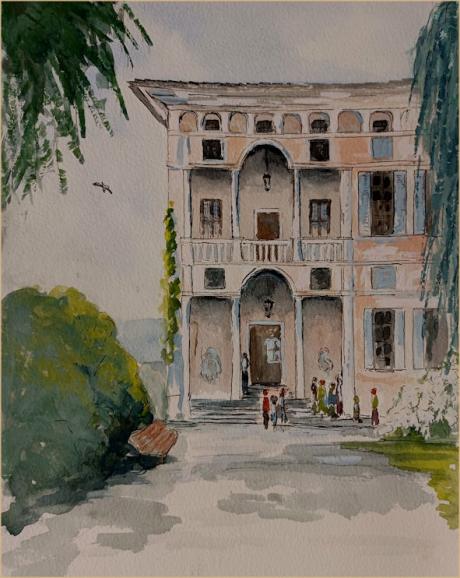" P Yates" and inscribed on the reverse
Unframed
Palazzo Borromeo, which was built on the southern shore of Isola Madre (Madre Island) on Lake Maggiore, also rises on the highest part of the island, thus dominating the landscape.
In 1501, Count Lancellotto Borromeo obtained ownership of Isola Madre from the Curia of Novara. From that moment, works started to make the island a private residence for the noble family. Lancellotto died only 12 years later, without having had the satisfaction of seeing his project completed. Works continued under his successors, and in particular under Renato Borromeo, who in 1585 entrusted supervision of the works to architect Pellegrino Ribaldi, who gave the building its current appearance: typical manneristic severity.
The building is L-shaped, and the longest section and most important rooms face south, in order to completely enjoy the sunlight. Access to the building is from the two landings, respectively on the north and south shores. The latter landing leads to the so—called della Cappella clearing, where there is a flight of steps leading to the next level and to the building’s main entrance. However, the north landing is more significant: past the gate, there is a flight of steps crossing the entire island, which finally leads to a square onto which the building looks. Climbing some more steps provides access to the ground floor, which is characterised (as is the first floor) by a loggia with arches flanked by square openings.
Starting in 1978, the Palazzo rooms were furnished with items taken from several historic Borromeo residences - including several works of art such as tapestries, furniture and 17th-century Lombard paintings in addition to dummies dressed with costumes from past centuries - with the intention of showing the lifestyle of the times.
The halls on the ground floor have a barrel vault, an umbrella dome and a cloister vault; a stairway connects them with the first floor, where the ceilings in the rooms are coffered or have wooden beams. The south-east room is rather picturesque due to the trompe-l’oeil decorations with pergolas, flowers and climbing plants. Also of interest are the Salone di Ricevimento (Reception Hall) whose walls are decorated with paintings of biblical subjects by Stefano Danedi (so-called Montalto), Ercole Procaccini the Younger and Giovan Battista Costa, the Sala delle Stagioni (Hall of Seasons) dominated by a majestic tapestry, and the Sala delle Bambole (Hall of Dolls) home to an important 19th-century doll collection from France and Germany. Another unique collection is the puppet and puppet-theatre collection dating back to the 17th, 18th and 19th centuries.
The Borromeo family sepulchral chapel (wanted by Vitaliano VIII and built in 1858) is located on the former site of the ancient Church of San Vittore. A marvellous garden surrounds the Palazzo. It is so remarkable that it was defined “paradise on earth” by Gustave Flaubert. It is home to precious and exotic essences, in addition to multiple fauna including peacocks, pheasants and parrots.

